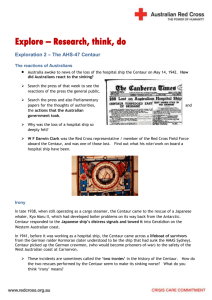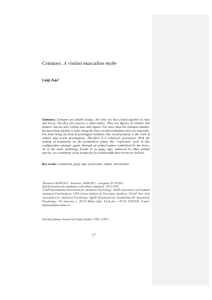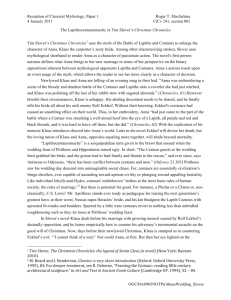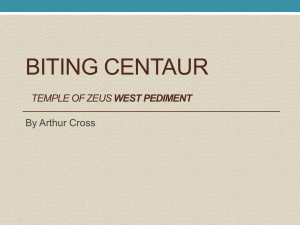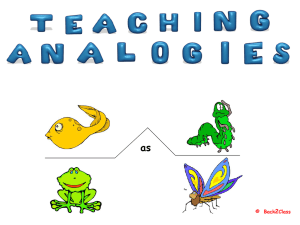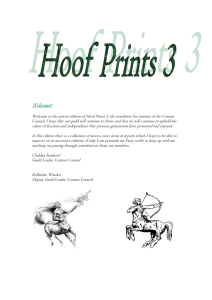Centaurs Unnaturally Fabulous
advertisement
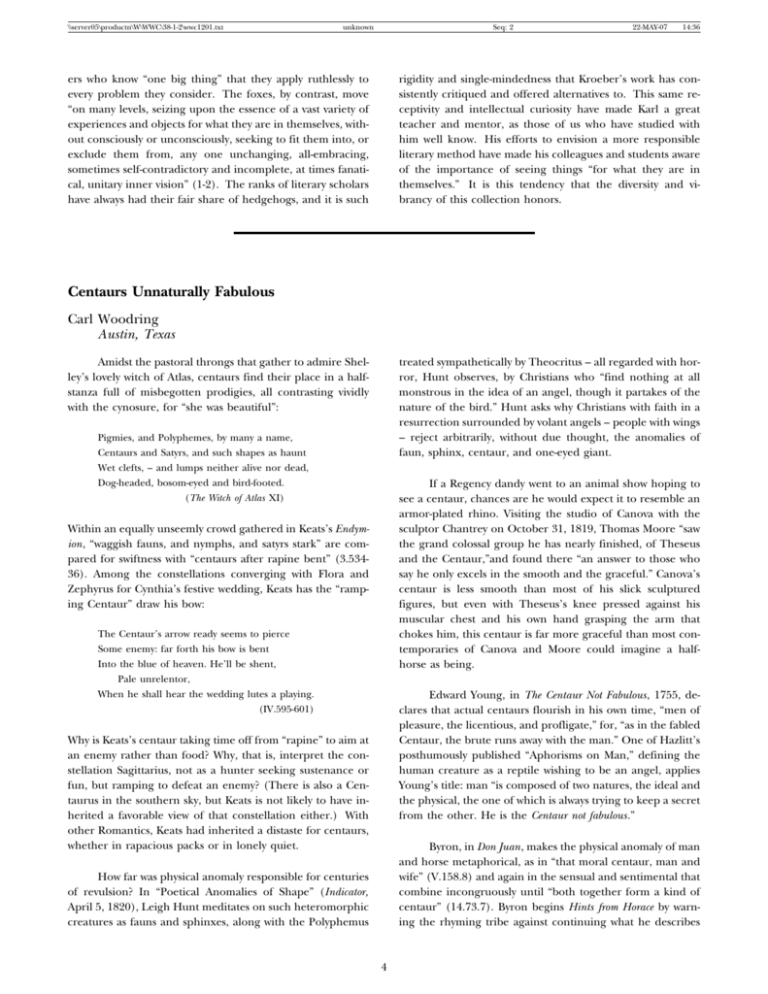
\\server05\productn\W\WWC\38-1-2\wwc1201.txt unknown Seq: 2 ers who know “one big thing” that they apply ruthlessly to every problem they consider. The foxes, by contrast, move “on many levels, seizing upon the essence of a vast variety of experiences and objects for what they are in themselves, without consciously or unconsciously, seeking to fit them into, or exclude them from, any one unchanging, all-embracing, sometimes self-contradictory and incomplete, at times fanatical, unitary inner vision” (1-2). The ranks of literary scholars have always had their fair share of hedgehogs, and it is such 22-MAY-07 14:36 rigidity and single-mindedness that Kroeber’s work has consistently critiqued and offered alternatives to. This same receptivity and intellectual curiosity have made Karl a great teacher and mentor, as those of us who have studied with him well know. His efforts to envision a more responsible literary method have made his colleagues and students aware of the importance of seeing things “for what they are in themselves.” It is this tendency that the diversity and vibrancy of this collection honors. Centaurs Unnaturally Fabulous Carl Woodring Austin, Texas Amidst the pastoral throngs that gather to admire Shelley’s lovely witch of Atlas, centaurs find their place in a halfstanza full of misbegotten prodigies, all contrasting vividly with the cynosure, for “she was beautiful”: treated sympathetically by Theocritus – all regarded with horror, Hunt observes, by Christians who “find nothing at all monstrous in the idea of an angel, though it partakes of the nature of the bird.” Hunt asks why Christians with faith in a resurrection surrounded by volant angels – people with wings – reject arbitrarily, without due thought, the anomalies of faun, sphinx, centaur, and one-eyed giant. Pigmies, and Polyphemes, by many a name, Centaurs and Satyrs, and such shapes as haunt Wet clefts, – and lumps neither alive nor dead, Dog-headed, bosom-eyed and bird-footed. (The Witch of Atlas XI) If a Regency dandy went to an animal show hoping to see a centaur, chances are he would expect it to resemble an armor-plated rhino. Visiting the studio of Canova with the sculptor Chantrey on October 31, 1819, Thomas Moore “saw the grand colossal group he has nearly finished, of Theseus and the Centaur,”and found there “an answer to those who say he only excels in the smooth and the graceful.” Canova’s centaur is less smooth than most of his slick sculptured figures, but even with Theseus’s knee pressed against his muscular chest and his own hand grasping the arm that chokes him, this centaur is far more graceful than most contemporaries of Canova and Moore could imagine a halfhorse as being. Within an equally unseemly crowd gathered in Keats’s Endymion, “waggish fauns, and nymphs, and satyrs stark” are compared for swiftness with “centaurs after rapine bent” (3.53436). Among the constellations converging with Flora and Zephyrus for Cynthia’s festive wedding, Keats has the “ramping Centaur” draw his bow: The Centaur’s arrow ready seems to pierce Some enemy: far forth his bow is bent Into the blue of heaven. He’ll be shent, Pale unrelentor, When he shall hear the wedding lutes a playing. (IV.595-601) Edward Young, in The Centaur Not Fabulous, 1755, declares that actual centaurs flourish in his own time, “men of pleasure, the licentious, and profligate,” for, “as in the fabled Centaur, the brute runs away with the man.” One of Hazlitt’s posthumously published “Aphorisms on Man,” defining the human creature as a reptile wishing to be an angel, applies Young’s title: man “is composed of two natures, the ideal and the physical, the one of which is always trying to keep a secret from the other. He is the Centaur not fabulous.” Why is Keats’s centaur taking time off from “rapine” to aim at an enemy rather than food? Why, that is, interpret the constellation Sagittarius, not as a hunter seeking sustenance or fun, but ramping to defeat an enemy? (There is also a Centaurus in the southern sky, but Keats is not likely to have inherited a favorable view of that constellation either.) With other Romantics, Keats had inherited a distaste for centaurs, whether in rapacious packs or in lonely quiet. Byron, in Don Juan, makes the physical anomaly of man and horse metaphorical, as in “that moral centaur, man and wife” (V.158.8) and again in the sensual and sentimental that combine incongruously until “both together form a kind of centaur” (14.73.7). Byron begins Hints from Horace by warning the rhyming tribe against continuing what he describes How far was physical anomaly responsible for centuries of revulsion? In “Poetical Anomalies of Shape” (Indicator, April 5, 1820), Leigh Hunt meditates on such heteromorphic creatures as fauns and sphinxes, along with the Polyphemus 4 \\server05\productn\W\WWC\38-1-2\wwc1201.txt unknown Seq: 3 by analogy as an imagined Thomas Lawrence abusing his art until “Nature, with a blush, / Saw cits grow centaurs underneath his brush.” In brief references elsewhere, the poet nods toward Nessus, bad, and at least once toward Chiron, good. 22-MAY-07 14:36 a conciliatory view of converting anomalous creatures rather than having a Sampsonian Hercules destroy them, but for most painters and writers with a Christian message centaurs were beyond redemption. According to Michael Camille, in Image on the Edge: the Margins of Medieval Art, the monks were fascinated by centaurs and other creations of classical myth that they denounced, but denunciation was the norm. Sassetta and Palma Giovane represent a regressive empathy with Greek leniency. Coleridge, in the Courier of August 31, 1811, creates an allegorical vision of blasphemy, superstition, and atheism, “a crowd of fiends . . . figures, here French faces, some with red caps and with crosses, and behind them an Hibernian variety of the Centaur genus, composed of a deranged man and mad bull,” eliciting “notions of the Irish massacre, and St. Bartholomew’s, and the Septembrizers” (EOT, 2.269 in the Collected Works). Centaurs here have stampeded from a Christian Hell through massacres of 1572 and 1641 and into Jacobin chaos. If centaurs had not been depicted, St. Paul would not have invented them, certainly not with the even-handedness of Greek myth. Monsters called centaurs had hardly begun to be horse-like in the 8th century BCE, the date of a relief vase from Boeotia portraying Medusa with the body of a horse, presumably because her father was Poseidon, god of horses, enabling her to die giving birth to Pegasus. Medusa, then, was horsy before centaurs were. Typically of the next step, a sarcophagus of the 5th century BCE, found in Sidon and now in the Archeological Museum of Istanbul, depicts a centaur with a large, handsome head and short torso. A similar Attic depiction in bronze, of about 530 BCE, heavily bearded, provided the title of a traveling exhibition of 2004: “The Centaur’s Smile: The Human Animal in Early Greek Art.” In these, and in centaurs as we know them, notably from Phidias, the human portion is an amiable horseman organically attached to the horse. “The Centaur,” says Thomas Bulfinch, “is the only one of the fancied monsters of antiquity to which any good traits are assigned.” Questioning the proposal in an encyclopedia that polo was invented by the Medes, A. P. Herbert suggested Hellenically that the probable originators were centaurs, “for whom, of course, it must have been the one obvious recreation” (”Polo,“ Punch, July 7, 1926). It was possible, in and near the Regency period, to have a detached view of the idea of a centaur, and to ascribe that view to an ordinary person: A man of any alertness at all “knows, that the conception of a Centaur, or the notion of the abstract number four, is one state of simple substance, as much as the conception of the trunk and limbs of a horse, or the upper parts of a man . . . ; but he knows also, that it is the very nature of that conception, and of that notion, to seem to be comprehensive of the other two; and the virtual analysis, by which he reduces this or other seeming compounds to their seeming elements, is, relatively to those of whose very nature such feelings of equivalence or comprehensiveness are a part, the same thing, as if there were a separate and distinct existence of the objects of thought thus regarded as equivalent, and elementary feelings as distinct, which were truly, and not virtually only, included in the more general feeling that seems to comprehend them.” Thomas Brown, M.D., Professor of Moral Philosophy at the University of Edinburgh, can be thus verbosely equitable toward centaurs in The Physiology of the Mind (1820, pp. 20-21) because as a student of mind he has other fish to fry, has used all the time he has without the sense of religiously committed poets and painters that centaurs are willful creatures. It is of no concern to him that God did not make centaurs, or that Noah was never drunk enough to see one. Brown avoided being unnerved by the Christian view of centaurs as savagely passionate, crapulous, lecherous, adulterous, uncouth followers of Bacchus and of Eros, in sum, the bestial in humankind, unalloyed emblem of unnatural heresy. From time to time some mythologist proposes as if from fresh inspiration that centaurs originated when the fierce Scythians clung as if imbedded on their admirable, enviable, speedy, and sinewy horses, arousing awe in a people instantly convinced that horseback was the way to go. As might be expected, Ben Jonson adopts that theory, explicitly in “Underwood LIII. An Epigram to William, Earl of Newcastle”: “When first, my Lord, I saw you backe your horse . . . . Methought I read the ancient Art of Thrace, And saw a Centaure, past those lakes of Greece; So seem’d your horse and you, both of a peece What, then, had artists and writers of the Romantic period in England learned about centaurs, and what had they ignored? Sassetta, early in the 15th century of the Christian era, depicted a scene in the life of St. Anthony Abbot as told inventively by St. Jerome. Jerome’s and Sassetta’s St. Anthony is aided in his search for St. Paul the Hermit by a centaur pointing the way and holding a palm branch of peace, indicating penitence and conversion to Christianity. Palma Giovane in Venice later portrayed an even more gracious centaur as a friendly ranger showing the way, and others took — like Perseus upon Pegasus, Castor on Cyllarus, or Sir Bevis on Arundell. In The New Inn Jonson has the host lament that the schools no longer teach with Pollux how to fence or “the Centaur’s skill, the art of Thrace, / To Ride,” but currently teach only the debased skills of cards and dice and how to pawn what they steal. It may have been Jonson who brought Byron to praise skilled riders in a similar way. In one version of Don Juan 5 \\server05\productn\W\WWC\38-1-2\wwc1201.txt unknown Seq: 4 14.35.7, Byron has Lord Chesterfield ride “like a centaur” as an equivalent of the astonishing Thracians. (In another draft, to provide a different rhyme, Chesterfield rides “beyond all price.”) Centaurs as conjunction of disparate creatures — unified, as Thomas Brown explained for us, in homogeneous idea — derive from the initiating vision of horse and rider as one. Within the Hellenic even-handedness, two or three clusters concerning centaurs in Homer, Hellenic vases, and other Greek sources provide fodder for a negative view. When Peirithous, a Lapith, in the normal course of hospitality invited centaurs to the festivities of his marriage with Hippodameia, which included general inebriation, one drunken centaur, Eurytion, made unwelcome advances toward the bride, which encouraged similar actions by his bibulous fellows. (It would not be Christian to observe that the name of the bride, Hippodameia, is half horsy.) In some accounts, when Theseus prevented Eurytion from abducting the bride, Eurytion as the solely invited centaur left in order to gain reinforcement from a troop of centaurs armed with stones and tree-limbs. When the male Lapiths present responded physically (in Antinous’ account, Odyssey 21, by cutting off Eurytion’s ears and nostrils), the result was the famous battle of centaurs and Lapithae, initiating, says Homer’s Antinous, war between mankind and centaurs. Although representations in stone and during the Renaissance in oils on board or canvas seldom favor one set of combatants over the other, in narrative prose and verse the centaurs were decidedly more culpable and were in consequence beaten back to the edges of the non-barbaric world. 22-MAY-07 14:36 this new love, Dejanira anoints a robe with the love-potion from Nessus. As arranged by Sophocles, Dejanira and Herakles each comes belatedly to believe that Nessus premeditated this murder. Guilty of delayed perception, Dejanira stabs herself. So great was the pain from donning the poisoned robe that Herakles directed his attendant to burn him in a pyre. (According to Sophocles the attendant was his son Hyllus.) Herakles, numerating his victories before this mean defeat by a woman (The Trachinae, in the English of R. C. Jebb), boasts particularly of defeating “that monstrous host of double form, man joined to steed, a race with whom none may commune, violent, lawless, and of surpassing might.” With such opponents taken into consideration, this Hercules, fused with Sampson, became occasionally almost a Christian saint, with suggestions of Christ harrowing moneychangers and Hell. Milton celebrated Herakles’ final agony, and Byron more than once found metrically useful the “shirt of Nessus,” a shorthand phrase for the robe smeared with a poison transmitted by Herakles to Nessus, from Nessus to Dejanira, from Dejanira to Herakles himself. In the Greek versions, Herakles was hoist by his own petard. If, unnoted by Sophocles, Nessus resented being murdered by Herakles and premeditated the final links in the fatal chain of events, he was so ingenious that Hyllus (who has promised to marry Iole) blames no earthly creature and ends The Trachiniae by declaring “in all this there is nought but Zeus.” Avoiding the issue of blame, Schiller celebrates acceptance of the Greek hero in high Olympus without mention of Nessus or Dejanira. A second cluster on centaurs, negative in most accounts, examines the several imbroglios with centaurs in the seldom peaceful career of the hero Herakles. Even when Herakles visited the wise centaur Pholus, the aroma of their shared wine attracted other centaurs eager to be rid of sobriety. In one unlucky encounter, Herakles needed the aid of the centaur Nessus to get the most recent wife Herakles had won in combat, Dejanira, across the river Evenus. Taking his fee as a Charon to get her over the river, Nessus found his passenger sufficiently attractive to attempt an abduction. His effort ended when Herakles shot through his heart an arrow poisoned with blood from the water-snake Hydra. Nessus in dying advised Dejanira to preserve a vial of his blood, which would draw Herakles to her again when the hero became interested, as often before, in a woman other than his current wife. The dying Nessus was acting with a generosity typical of his kind. When Herakles, in the art-history sense, raped Iole and asked Dejanira to send him a white robe to honor the gods that enabled him to destroy Oechalia, city of lole’s father, Dejanira sent a robe smeared with the blood of Nessus. Modern versions usually ignore the irony central to the myth: Herakles knew that the blood was poisoned; Nessus and Dejanira did not. In general, Christian accounts of centaurs got along without Chiron, noble instructor of heroes. Chaucer was aware of “proud Centaurs,” Chiron as well as Nessus. Skelton lustily contemplated not only Hippocentaures but also Onocentaures, with the bosoms of women. Spenser maintains a Christian view of “th’ halfe horsy people” who fought with the equally “bloudie Lapithaes” (Virgil’s Gnat 41-42). Even Chiron, “seed of Saturne, and faire Nais,” he introduces as “the dreadfull Centaure” (Faerie Queene 7.7.40). Spenser evokes Nessus and Hercules as pre-Christian, from a time when “Centaures blood and bloody verses charmed” (FQ 1.11.27). As in Keats later, centaurs in Spenser keep ugly company: “Crocodiles, Dragons, Beavers, and Centaures”; “Infernal Hags, Centaures, feendes, Hippodames,” who assault reputable castles and collect in the Bower of Bliss (Mother Hubbard’s Tale 1124; FQ 2.9.50). Creatures that have become half horsed belong with other drunken souls in Hell (FQ 4.1.23). Ben Jonson, when horsemanship is not the issue, avoids granting to centaurs any moral superiority. In Epigram 133, “On the Famous Voyage,” the poet reports seeing in and near Fleet Street – amidst “stench, diseases, and old filth” – “your vgly Centaures, ye call Car-men, Gorgonian scolds, and Harpyes.” In The Trachiniae of Sophocles, Herakles sends Iole to Trachis, putting her under the care of Dejanira, one of the most tolerant wives on record. To reclaim her husband from 6 \\server05\productn\W\WWC\38-1-2\wwc1201.txt unknown Seq: 5 Aside from neutral references to the inn named Centaur in The Comedy of Errors, centaurs tramp gracelessly through Shakespeare’s plays. A character named Chiron, one of the sons of Tamora in Titus Andronicus, acting in revenge against Titus with his brother Demetrius, cuts off the hands of Titus’s daughter Lavinia. Later, coming to Titus disguised as Rape and Murder, the brothers promise to dispose of any enemies of Titus that have been charged with those crimes. In his plan to serve up Chiron and his brother to their mother, Titus vows that this banquet will prove more “stern and bloody than the Centaur’s feast” (V.2.203). This Chiron has no discernable connection with any in classical sources, but Titus is presumed by scholars to refer to the feast of Peirithous where centaurs misbehaved, directly referred to by Theseus in A Midsummer Night’s Dream when he rejects, as inappropriate for a kinsman of Hercules, “The battle with Centaurs, to be sung / By an Athenian eunuch to the harp.” In Denmark Claudius does indeed describe a horseman so fine that his riding had “witchcraft in’t”: 22-MAY-07 14:36 strant’s Defence against Smectymnuus that we, if basely inclined, may “make ourselves bastards or Centaurs.” Swift, in an answer to “a late scandalous Poem” by Thomas Sheridan, would describe in comic detail the sequence when “Jove dressed a cloud in Juno’s shape” to produce centaurs as nubigenae, born of a cloud. In Paradise Lost Milton more subtly than Lear locates Satan astronomically between the centaur and the scorpion: behold Satan in the likeness of an Angel bright Betwixt the Centaur and the Scorpion steering His Zenith, while the Sun in Aries rose: Disguised he came . . . . (10.327-30) A position astronomically neutral, but in 1936 the scholar D. C. Allen appealed to astrology and found there that Scorpio and the Centaur, like Satan’s disguise, signify deceit (MLN [1953] 68.361). He grew unto his seat, And to such wondrous doing brought his horse As had he been incorps’d and demi-natur’d With the brave beast. (Hamlet 4.7.85-88) Dryden is not morally responsible for the many centaurs in the works he translated from Virgil, Ovid, and Juvenal; his own allusion in a tilt at Italian and French absurdities tells no more than does the opening of Hobbes’s Leviathan, where centaurs are an example of memory colliding with imagination. For the purposes of Dryden and Hobbes, centaurs like sphinxes expose inferior mental activity. Shakespeare’s best opportunity to explain the reference by Titus comes with Lear’s denunciation of Regan and Goneril: Down from the waist they are Centaurs, Though women all above; But to the girdle do the gods inherit, Beneath is all the fiends’: there’s hell, there’s darkness, There is the sulphurous pit, burning, scalding, Stench, consumption. Fie, fie, fie! pah, pah! (King Lear 4.6.124-29) Later in the 18th century English artists began to show a more sympathetic interest in centaurs, derived notably from painting, graphic arts, and sculpture of the Renaissance in Italy. If D.Vinckeboons (1576-1629) depicts in the abduction by Nessus a Dejanira leaning with arms outstretched toward Hercules, Italian versions often display her as a ravishing nude; some, like Pollaiuolo’s, make Dejanira’s expression closer to ecstasy than to fear. English artists were far more circumspect, but neutrality became a resurrected aim in depicting Lapiths or Hercules against centaurs. In a sketching club founded by Thomas Girtin, with centaurs apparently set as the subject on a day in 1803, John Sell Cotman placed in a scene like Greta Woods a muscular nude male driving a lance into the breast of a centaur. Cotman’s title for the sketch is The Centaur, without mention of Hercules or any successful man. Illustrating the passage on violence and brutishness in Canto 12 of Dante’s Inferno with a discipline not often associated with eternal torment but consonant with Dante, John Flaxman’s Encounter with Centaurs presents (typically for Flaxman) three centaurs in a regimental line calmly shooting arrows. Lear sends centaurs to a Christian hell. Humanists in Italy had begun to recapture complexities in the classical record. Soon after Shakespeare, Pedro Calderon de la Barca, in the play translated by Edward Fitzgerald as The Painter of Dishonor, has a wronged husband describe a self-referential painting in which “the faithless Centaur carries off Deijaniera” while a fiercely jealous Hercules looks on with evident determination to secure revenge. In a second scene on the same canvas Hercules prepares “his own funeral pile” to illustrate the motto of the whole, “So Jealousy in its own flames expires” Milton, predictably, continues instead, in both verse and prose, the Christian revulsion against centaurs. He exploits in prose their dubiously divine heritage: Ixion, son of Ares, coveted Hera, wife of Zeus, whereupon Zeus formed a cloud in the likeness of Hera. Ixion obligingly begot upon this cloud Centaurus, originally described as a monstrous shaggy giant, who then fathered upon the mares of Pelion the race of centaurs as limned by Phidias. Because centaurs are “fruits of delusive marriage,” Milton proposes in Animadversions upon the Remon- In 1772, James Barry painted Chiron and a nude Achilles with lyre, both facing the viewer, as The Education of Achilles, a scene that Flaxman also delineates. Homer, Euripides, Virgil, and a thousand others agree that Chiron is the most righteous and wise of the centaurs. He taught Asclepius the art of healing and Melampus the power of prophesy. (In Ru- 7 \\server05\productn\W\WWC\38-1-2\wwc1201.txt unknown Seq: 6 bens’ sketch of Achilles astride Chiron and learning various arts, Apollo is the terminus on the right and Asclepius on the left.) Chiron did a good job of educating Jason, except that he somehow allowed the young hero to appear before Pelias shod with only one sandal, which resulted in Jason’s perilous assignment to leadership of the Argonauts in pursuit of the Golden Fleece. 22-MAY-07 14:36 wooed by Zeus and Poseidon and hence in shame welcomed transformation into the linden tree. Chiron’s blood was aerated with divine ichor. By the middle of the 19th century properly educated Englishmen began to regard centaurs with less emphasis upon inebriation and violence. Centaurs decorate sensuously Arnold’s early poem “The Strayed Reveller” and similarly adorn Empedocles on Etna, where Chiron is observed teaching Achilles to explore the mountains, while tired centaurs come to rest nearby (1.2.59-63). In the shorter poem Arnold is markedly even-handed; the Youth sings of wisdom, as from Chiron (223-25), but also of “maddening wine” that leads to conflict with the “grim Lapithae.” On that battle and on centaurs in general his sympathetic view derived in part from Maurice de Guérin’s prose poem Le Centaure and perhaps also from Le Genie des Religions (1842) of Edgar Quinet. One message is clear: the centaurs are an essential element in nature. The Guérin work ends, translated by Charles Whibley in the Magazine of Art, August 1892, “soon I shall mingle with the rivers which flow into the spacious bosom of the earth.” Centaurs had become an endangered species necessary for a wholesome environment. Besides saving Peleus from the treachery of Acastus, Chiron taught Peleus how to make Thetis stop changing shapes and how to seize her in order to marry her and provide birth to Achilles — thus fulfilling altogether the will of Zeus. Then, introducing young Achilles to other heroes and princes enjoying his tutelage, Chiron taught him the skills of riding and hunting, such arts as mastery of the lyre, and the mystery of the world’s origin. Dante learned from Statius’ Achilleis how Thetis took her son from the care of Chiron to Scyros in an effort to preserve him from the expedition to Troy (Purgatorio 9.3439). Dante accepts from classical tradition that the centaur Pholus was like Chiron an educator, but repeats from Virgil only a widely known detail: Pholus was “full of fury.” Unlike Nessus, furious Pholus died un-heroically by dropping one of Heracles’ poisoned arrows on his foot. Although among accountable creatures in the Seventh Circle of Inferno because violent, the leading centaurs remain valuable guides; the rest serve as police. Dante identifies even Nessus, after Chiron, as il gran Centauro (Inferno 12.71, 104). It is not Dante who wills the centaurs into hell; in a thoughtful Christian scheme of things, he found them there, even Chiron, much as very early poets had found them in Thessaly. Superior equestrians in Thessaly, they were tutors and police in the hell Dante visited. Similarly George Meredith, whose eccentric education differed decidedly from Arnold’s, has the alter ego in his proclamation of faith, “The Woods of Westermain,” temper the blood but hear “the heart of wildness beat / Like a centaur’s hoof on sward,” for Drink the sense the notes infuse, You a larger self will find: Sweetest fellowship ensues With the creatures of your kind. (120-25) Most of the English Romantics would have noticed, among other sources, Rousseau’s observation that it would have taken the skill of Chiron himself to make a light-footed Achilles of Emile. Byron refers to “Achilles, with the centaur’s lyre,” in an idyllic context (The Island 2.85). Coleridge, annotating Jean Antoine Dubois, makes a centaur, presumed by Coleridge’s editor George Whalley to be Chiron, intermediate in a scale of the semi-divine. These also are findings rather than placings. Attitudes toward centaurs were to proceed in a direction very different from the pantheism of Guérin. As taken partly from Renaissance painting and sculpture, Chiron would become the paragon for instruction and accomplishment in the arts, distinctive, differentiated, separated, precluded, emblem of the creative persistently rejected and despised by conformists and uncultured Philistines. Centauric artists of the late 19’ century are the unnaturally creative, at times explicitly bohemian or homosexual, but always at least half other than routinely human. Marilyn R. Brown traced in Gypsies and Other Bohemians: The Myth of the Artist in Nineteenth-Century France (1985) this one strand in the ensuing courtship of artists and social dissidence. Emphasis on the homoerotic can be read from René Kieffer’s fauns or satyrs riding and unconventionally holding hands with centaurs. Dante had represented il gran Chirone, il qual nudri Achille, as instructing Nessus to guide Dante and Virgil to where other centaurs were patrolling bloody tyrants like Alexander and Attila. In an act reported by Hellenes but relegated to oblivion by fundamentalist Christians, Chiron had descended into Hades as redemption for Prometheus. Only a heretic could notice a parallel between Chiron and Christ in this descent and redemption. Chiron could descend safely into Hades because, distinct from other centaurs, he had not been afforded birth by a cloud. Kronos, to evade vigilance by Rhea, had changed himself into a horse, in which form he begat Chiron upon Philyria, an Oceanid who had been The change of emphasis from Nessus to Chiron took several routes. Delacroix, who had copied from the Parthenon reliefs Theseus’ vanquishment of the centaur Erytos and from a Pompeian source a female centaur banging cymbals 8 \\server05\productn\W\WWC\38-1-2\wwc1201.txt unknown Seq: 7 with a nude woman, appeals often in his art and writing to Chiron’s education of Achilles. An admirer of Rubens, Delacroix declared ludicrous, in his journal for January 26, 1852, a tapestry now lost, in which, he said, Rubens’ Achilles seemed fresh from riding school and ready for an equestrian portrait. Delacroix corrected this insult in a pendentive of the Palais Bourbon by having Chiron wear a laurel wreath as he points to the bird he has taught young Achilles to pierce. 22-MAY-07 14:36 tions of Shakespeare by Granville-Barker and Lewis Casson, he survives notably in books on the Symbolist movement, Decadence, Art Nouveau, and the fantastic, and can stand here as central to the views of the centaur in the Yellow Nineties. The centaur is as emblematic for Ricketts as the wounded Amazon and the Atalanta who slew the centaurs Rhaetus and Hylaeus are for his housemate, Charles Shannon. Admiration for centaurs emerged in some of Ricketts’ earliest works in oil, Centaur and Child, Centaurs Quarrying, and Centaur Swimming. Although he often painted Biblical subjects, his swimming centaur does not represent the Christian tradition that centaurs hid themselves in rivers as evidence of pagan surrender to Christ, a point lokanaan makes in Wilde’s Salome: “Les centaures se son caches dans les rivières, et les sirènes ont quitté les rivières et couchent sous les feuilles dans les forêts.” Wilde’s tale of the man who said after watching mermaids, a faun, and a centaur, “Today I saw nothing,” led Gide to take the remark literally, but Ricketts explained it as one man becoming skeptical in convincing another. Ricketts agreed with Wilde that the “truth is rarely pure, and never simple.” Barye, Daumier, Fromentin, Mardes, Rops, Moreau, Stuck, Legros, Böcklin, Rodin, and in North America, William Rimmer before Paul Winship, joined the celebration of centaurs. Odilon Redon’s refined archer of 1895 aims at the clouds. In 1904, Julio Ruelas has a centaur introduce the Maecenas of the Symbolists, Jesus Lujan, to the Rivista Moderna. Eduard Kampffer depicts rearing centaurs felling nude bacchantes with pizza-like disks, while lion and tiger watch expectantly. Bourdelle’s Dying Centaur is headless but with lyre intact. Franz von Stuck is partcularly significant because the centaurs that decorate and nearly fill Villa Stuck in Munich are emblems of the Secession, close cousins of those in Berlin and in Vienna, where centaurs brought a quick update to the Akademie der Bildenden Kunst. Centaurs thus succeeded Castor and Pollux as guardians of education in the arts. This dominant symbol of art education promptly reached England, where the Walker Art Gallery of Liverpool issued two or more posters of centaurs, one a comic drawing of bearded centaur courting a tall, draped Grecian, afforded a full page in The Poster of January, 1899. Centaurs promulgated as icons of academy and gallery prepared viewers for the paintings and sculpture of centaurs inside, somewhat as the significance of the lions guarding the New York Public Library is enhanced for readers by the television program “Between the Lions.” In the second number of an occasional periodical edited by Ricketts and Shannon, the Dial, 1892, Ricketts created a woodcut for an unsigned piece on Guérin and probably wrote the article. In his idyllic headpiece, a centaur gazes at a nude who spills liquid from a jug as she falls backward. For the next Dial Ricketts “interpreted” a design by Reginald Savage for a wood engraving of centaurs, an engraving he continued to exhibit at least until a notable Dutch Gallery exhibition of 1898. In 1902, he exhibited at the same gallery Nessus and Dejanira, a small oil on canvas in darkened colors influenced by Daumier. An unclothed, bearded centaur looks down a little beyond the upturned face of the supine, nude, muscular Dejanira. This amorous scene was sometimes exhibited as A Centaur Idyll. A mounted photograph of the painting appeared in 1905 in the third number of The Venture, edited by Laurence Housman, who was rapidly ceasing to be a disciple of the irascible Ricketts. All in the art world of London would have recognized the models for Nessus and stolen bride as Ricketts and Shannon. Artists utilized themselves and friends economically as models, no problem there, but Ricketts’ representations of women, as in the wood engravings of Daphnis and Chloe, The Sphinx for Wilde, and the Vale Press Hero and Leander, had been decadently wee-breasted figures taller and leaner than El Greco’s saints. This bold defense of Nessus’ “rape” portrayed a willing Dejanira with strong shoulders, arms, and calves. Ricketts was not yet ready to publish his account of visiting Wilde in Reading Gaol, and risked it later only under a pseudonym. Nessus and Dejanira was widely accepted and praised for its romantic approach to a classical subject. As successor to Guérin, Jose Maria de Heredia, born in Cuba but flourishing in France, kept alive the intellectual heroism of centaurs, but brought them into fin-de-siècle culture by awarding them a Christ-induced miasma of guilt, nostalgia, and melancholia. Les Trophées (1893), which collects Heredia’s poetry, begins with the series “Hercule et les Centaures.” Characteristically, in “Fuite de Centaures,” these unceasingly emblematic creatures flee (from the religion that condemned them) drunk with rebellion and violence. A few years later painters who studied the sexual excesses of Klimt and Schiele could revel in the fierce lust of centaurs without negative aesthetic implications. In England the aesthetic cult of the centaur collects particularly around the painter, sculptor, book artist, theatrical designer, and connoisseur Charles de Sousy Ricketts. Although he designed books not only for Wilde but also for Hardy, Yeats, Gordon Bottomley, and the British Legion, and designed costumes and sets for the Abbey Theatre, Shaw, Yeats, Binyon, Arnold Bennett, D’Oyly Carte, and produc- Laurence Binyon, T. Sturge Moore, and other disciples of Ricketts testify that the relationship between Ricketts and Shannon was not homosexual, but Ricketts was a generally 9 \\server05\productn\W\WWC\38-1-2\wwc1201.txt unknown Seq: 8 misogynistic pederast who as an artist swam among centaurs as emblematic of the wise, talented, trained, creative, tabooed male. In the 1890s centaurs represented for Ricketts, as they did in aesthetic Vienna, not a crude union of spiritual and bestial, but a cohesion of the intellectual, spiritual, and physical — man made whole by artistry, the transcendency of art over nature. 22-MAY-07 14:36 To begin the episode Ricketts draws upon, Goethe has Faust address Chiron as “der grosse Mann, der edle Pädagog,” the man who molded the noble race of Argonauts. Faust then mounts this mighty man-like teacher and begins to learn, for example how Chiron taught heroes which plants would heal wounds. In Ricketts’ painting, Peneios looks toward the nymphs and points toward Chiron, thus emphasizing the theme of instruction. Lewis Hind, for his review in 1910 of the exhibition of the International Society of Sculptors, Painters and Gravers, reproduced the Centaur and Baby Faun and concluded: “Then there was Faust and Chiron, the centaur Chiron of Greek mythology renowned for his wisdom and skill in medicine, hunting, music and prophecy” (International Studio 39.262). In conversation Ricketts downplayed the emblematic significance of centaurs as subject in his work. C. Lewis Hind, in Adventures among Pictures (1904), eagerly took that line with regard to Nessus and Dejanira and its companion paintings: “The subjects of them are Centaurs, but those fabulous beasts are pictorial aids to the pictures, not their determining incidents. In one they are seen hurrying down a slope bearing huge weights upon their heads.” The “uncouth figures,” Hind explained, fill the center of a wild landscape in a small picture. In the International Studio of February, 1910, reporting on a conversation with Ricketts, Hind would continue to protect his readers from the icon of Secessionist art: Ricketts “loves a centaur or a mermaid, anything fabulous and strange; but I think his deepest feeling is evoked by some poignant episode from the New Testament.” Ricketts had done woodcuts for The Parables (Vale Press, 1903) and oils of the Good Samaritan from roadside to inn, but Hind grants that the Crucifixion, like the centaurs, would be for Ricketts not a theme but “a subject for decorative treatment.” Thus, paradoxically, the centaur as symbol for artist as abnormality became in the 1890s integral to art as decorative treatment. For most laymen there was no paradox; art as decoration was as much abnormality as one could bear. The exhibition of Ricketts’ (and Shannon’s) work in Buffalo and Manhattan in 1914 included a “Pencil drawing for ‘Centaur and Lapith’.” An inaugural exhibition at the Minneapolis Institute of Arts the next year included Ricketts’ ”Children and Centaur,“ purchased for the museum. These drawings are probably two drops from a large bucket. A panel by Bortolommeo di Giovani depicting the fight between the centaurs and the Lapiths, acquired by Alexander Barker in 1874, had been exhibited at Burlington House in 1880 and at the New Gallery in 1893. When rejection by or for the Louvre made The Fight between the Lapiths and the Centaurs by Piero di Cosimo available in England in 1901, Shannon and Ricketts tried to enlist others to acquire its eight feet of violence for the “ungrateful nation”; when it became available again in 1904 for less than their average annual income, Shannon and Ricketts acquired it and willed it to the National Gallery. When Walter Sicken saw it at Burlington House (after Ricketts’ death, but before Shannon’s), he said in the Fortnightly Review, February 1930, “Occupat os saxo, but it is the Centaur’s Sunday face.” An exhibition arranged by Martin Birnbaum in 1914 for the Albright Art Gallery in Buffalo and the Berlin Photo Company in New York included among nineteen bronzes by Ricketts three centaurs: Centaur and Faun, Centaur and Nymph, and Faust and the Centaur. An extant Centaurs and the Bacchante is perhaps of a later date. Accident prevented a quite different painting from remaining in England. To pay for the healthcare of Shannon, who had fallen while hanging pictures in a stairwell, Ricketts sold Gustave Moreau’s Chimera (1867), to Grenville L. Winthrop, who donated it with other treasures from Ricketts to Harvard’s Fogg Museum. In this vivid anomaly by one of Ricketts’ mentors a nude female clings to a winged and feather-legged centaur. A painting, Faust Riding the Centaur, of about 1908, was reproduced muddily in Charles Ricketts, R.A., Sixty-Five Illustrations (1933), edited and introduced by a follower and executor, T. Sturge Moore. It has been implausibly suggested that the centaur here, unquestionably Chiron, “may represent man’s baser nature.” Unlike the sturdy modeling of this episode for Ricketts’ bronze Faust and the Centaur, horsiness in the painting is largely concealed by Peneios and the nymphs called for in Goethe’s Faust 2.2. 766-921 — called for, but probably welcomed to hide evidence that Chiron was half horse rather than horse and rider. (The rump of the nymph in the foreground is almost feminine, a change that began in Ricketts’ sculptured figures, for example his Orpheus and Eurydice, suggesting that his practice of drawing female forms from boys as models could be occasionally interrupted by borrowing models from Shannon.) Less anomalous centaurs flourished within the Ricketts circle. In the Silverpoints of John Gray (1893), originally to have been paid for by Oscar Wilde but in the event designed and controlled for publication solely by Ricketts, three poems with allusions to dual nature bear in Gray’s manuscript the titles “Mishka (The Centaur),” “Song of Vines (The Centaur),” and “Summer Past (The Centaur).” Probably in agreement between Gray and Ricketts, the volume was dedicated to Wilde. 10 \\server05\productn\W\WWC\38-1-2\wwc1201.txt unknown Seq: 9 Illustrations by Ricketts accompanied the Whibley translation of Guérin’s prose poem in the Magazine of Art. In 1899 Ricketts chose for his Vale Press two Guérin poems, The Centaur and The Bachante as translated by T. Sturge Moore with wood-engravings by the translator of a centaur that is animal, spiritual, and of such divinity as earth affords. The centaur then took a path from the generally aesthetic to fine printing in particular. When Bruce Rogers designed a clearer font than the first that Ricketts designed for the Vale Press (used also by Lucien Pissarro for the earliest books of the Eragny Press), Rogers chose the foundational work by Guérin for the first volume published; named the font the Centaur Type; included in his Centaur Press publications such as Peri Cotgrave, The Little Centaur and Other Verses; and printed specimens of Monotype Centaur in 1949 as The Centaur Types. 22-MAY-07 14:36 simplicity, with no fear of Apollo or other gods. These children, stronger than “pupils of Chiron,” can be expected to live in a bucolic purity that will enable one of them to avenge the slaughter of centaurs till “hooves on him grow.” With idyllic nature in danger, the last female centaur dead from the arrows of men, and no pair saved by Noah, why should the courageous Pholus and Medon not make a last desperate effort to revive their kind? In “The Song of Cheiron,” in Moore’s volume The Sea Is Kind (1914), the wise centaur revels in his superiority over “the wisest of men,” those who ride his back and learn from him as he races over the landscape that he mutely worships – huge cisterns, cliffs, tarns, “maddening, grander, divine.” With a man on his back he is conscious of also carrying man within his full, complete being, their fused adventurous mind discovering its kinship with the silence of stars. Re-spelled as “The Song of Chiron,” the poem was included in the Collected Poems of 1931-33 (3.89-90), among “Exultations and Adorations.” The centaur is not for Moore a homoerotic emblem, but the misogyny of his Pholus may be a characteristic inherited from Ricketts. No horse could he more entranced by centaurs than Sturge Moore was. In 1896 his sonnet, “Pallas and the Centaur: After a Picture by Botticelli” appeared in the first number of the Pageant, of which Shannon was co-editor. The painting, then recently discovered in the Pitti Palace, had been given a title and reproduced the previous year in the Magazine of Art; it was reproduced again so that readers of the Pageant could better appreciate Sturge Moore’s interpretation. While the left hand of the dubiously identified Pallas Athene holds a decorative battle-axe (“golden halberd”), she extends her right hand to grasp the hair of the bearded centaur, calls out, “Centaur, sweet Centaur, let me ride on you!” and gives instruction to the centaur on visiting Egypt’s Mary: “Clamber on clouds to Mary-Mother then.” Although art historians have assumed that Botticelli’s Nessus as abductor represents lust (versus purity), the painting provides an expression of regret equally to the maiden and to the centaur. Moore’s Pallas looks toward a future of redemption and joy. Ricketts’ mother was French; he and Shannon first hurried abroad to meet Puvis de Chavannes; and most French artists who came to London came with letters to Ricketts; it may have been easier to forgive Sturge Moore for marrying because the bride was French. Moore would succeed Ricketts as designer of books by Yeats (for whom Ricketts also designed costumes, including one for public reading as The Jester); but the indirect connection of Ricketts and Yeats through centaurs originated with the émigré Edmund Dulac (who caricatured Ricketts and Shannon as frequently as Beerbohm did, and even more joyfully). For Dulac and Yeats the homoerotic aspect of centaurs is minimal. For them, as for Arnold, the centaur is emblematic of an ideal past when culture had not strayed into separation from nature. A wood engraving by Moore of uncertain date, The Centaur’s First Love, was reproduced in the second number of Form: A Quarterly of the Arts, in April 1917: reclining in the manner of a horse, the faunish centaur embraces a tree. (A second version of this design appeared in a Colnaghi catalogue of 1972.) Dulac did as an illustration for Hearst’s American Weekly an indirect defense of Nessus in “Hercules and Dejanira”; a similar work, The Centaurs and the Lapith Women, survives in a private collection. In Seven Poems and a Fragment (1922) and again in The Tower (1928, cover by Sturge Moore), Yeats published “On a Picture of a Black Centaur by Edmund Dulac.” Yeats speaks not of a dual nature but of a divided mind. “Your hooves have stamped at the black margin of the wood . . . . I knew that horse-play, knew it for a murderous thing . . . . Moore’s volume The Centaur’s Booty (1903) was “Affectionately Dedicated to C.S.R.” The title poem is a dialogue between two old centaurs. At first Pholus meditates as the last of his kind, but Medon, a second survivor, arrives with a child he has taken from a woman who pushed this son from her breast. Pholus insists that women weaken those who love them; both he and Medon have loved women and in unlike ways lost. Medon, addressing the child as “you rogue, my booty,” explains that the woman would have come with him, but she can have more children, whereas the last two centaurs, as their final hope, can at best raise this child to live on berries until he can eventually have a woman who, slipped from her dress, will raise their naked children in centauric I have loved you better than my soul for all my words, And there is none so fit to keep a watch . . . . Although Yeats probably knew of Dulac’s own centaur bookplate, perhaps knew of the similar plate Dulac did later for the Book Society, and certainly knew of Dulac’s sketch of male and female centaurs for a bedcover to be embroidered 11 \\server05\productn\W\WWC\38-1-2\wwc1201.txt unknown Seq: 10 by Lilly Yeats, the Dulac biographers Colin White and Elizabeth Loizeaux both suspect as inspiration for the poem by Yeats, not any of these, but Dulac’s illustration, “The Good Chiron Taught His Pupils How to Play upon the Harp,”in a 1918 edition of Hawthorne’s Tanglewood Tales that Dulac decorated in various ways. Out of Dulac’s original sketches evolved a more careful watercolor on board, The Rape of Dejaneira, for a series of “Famous Myths.” This Dejanira, like Pallaiuolo’s and Botticelli’s, is in a position to appreciate her emotional gain from the rape. 22-MAY-07 14:36 The bi-natural population of avant-guard art inevitably attracted caricatures. In Punch of June 11, 1881, a centaur explains the Derby to a Yankee Indian. Leonard Raven-Hill, an artist for Punch who had been a roommate of Shannon’s and classmate of Shannon and Ricketts at the City and Guilds Technical Art School, includes among his light-hearted drawings for The Butterfly in 1900 a centaur attacked by a bull. Between and after novels on conflicted mind entitled The Centaur, by Algernon Blackwood in 1911 and John Updike in 1963, many major and minor writers and draftsmen had renewed the attention to centaurs of the Renaissance and the Yellow Nineties. The Jonson-Byron view is represented in Edward Larocque Tinker’s Centaurs of Many Lands; these centaurs are men who ride exceptionally well, Lipizzaners of Vienna, Spahis, gauchos, and Franco’s horsemen in Morocco. The ironies inherent in Dulac’s work are multiplied in paintings by Glyn Philpot, a young painter Ricketts befriended and encouraged. Philpot’s Repose on the Flight into Egypt fuses the naive and cynical in the manner of Wilde’s fairy tales (and the reports from the netherworld in Ricketts’ Beyond the Threshold). While two centaurs out of the Saturnian age of well-being watch from the background, a grouped nude, faun, and centaur come upon the clothed and covered figure of Mary holding her child. Joseph crouches with his head on his knees. A black Egyptian sphinx, wings alert, watches with a concern for disrupted traditions, in reactive counterbalance to the replaced three wise men, who if present would be celebrating “the triumph of the God of the Hebrews” rather than the end of an idyll here lamented. In the second quarter of the twentieth century many centaurs grazed in a field beyond good and evil. The New Yorker began then, and has continued, to caption drawings of centaurs for A. P. Herbert’s kind of humor: Centaurs and fauns need a physician trained as veterinarian. Woman in supermarket with centaur husband explains, “Derek and I have always been very aware of the nutritional value of whole grains.” Man in RV reports to wife the answer of centaur as park ranger: “He says we’re already in the Garden of the Gods.” “You think you’re the only one around here with an identity crisis?” Centaur asks mermaid, “What’s all the big fuss about genetic research?” Exchange between woman on horse and centaur, “It happens that neither of us is interested.” When Noah’s son reports disconsolately to his father that the unicorns are gay, perhaps that Noah had already rejected centaurs for the same reason. Philpot’s Melampus and the Centaur, 1919, purchased for the Glasgow Art Gallery in 1923, equally rejects the legends of conversion and again celebrates the golden age when centaurs were ascendant. Philpot’s Chiron is teaching Melampus how to become the first Greek Physician. “Despite its allegiance to Ricketts in choice of subject,” said Robin Gibson in 1984, “it is painted with a considerable directness and vividness”; J. G. P. Delaney, in Charles Ricketts: A Biography (1990), suggests that Philpot’s increasing freedom from (stylistic) influence decreased Ricketts’ admiration for his work. Refusal to pass moral judgment appears representatively in a poem by A. D. Hope, poet, novelist, and vituperative critic claimed by South Africa, Australia, and England. In his narrative poem The Countess of Pembroke’s Dream, Mary Herbert imagines that she and her brother, Sir Philip Sidney, become, in the un-splintered world of ancient Thessaly, two centaurs, male and female, the subject (in her dream) of a song by Chiron, in which their human elements clasp breast to breast before they engender equine offspring. In the twentieth century unnatural creatures could perform natural acts without heavily mythological, psychological, or Christian implications. For the illustrations to his own Beyond the Threshold, 1929, Ricketts resurrected his very early indebtedness to the Aldus Hypnerotomachia Poliphili of 1499. In two illustrations centaurs play a peaceful role. In the first the shaft has just left the centaur’s bow in the background of “The Head of Orpheus. ” In the second, “The Birth of Pandora, ” an androgynous centaur in the background effortlessly blows a trumpet. In the misogynistic text, however, Plato recounts the sad tale of Pandora as heard from Diotima, and sets the scene in language theretofore foreign to Ricketts as the centaur’s champion: “Man was still in his savage infancy, uncouth, and rougher than the shaggy centaurs.” 12

